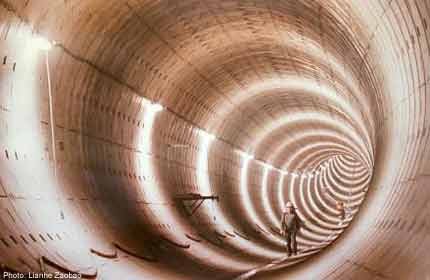Singapore digs deep for ideas to build downwards

Underground classrooms, libraries, swimming pools and even a science city for up to 4,200 workers - these are some of the proposals which have been unearthed even as studies into Singapore building downwards gather pace.
So far, the country has already engaged in several major underground projects, including a common tunnel under Marina Bay for telecommunications cables, power lines, water and refuse pipes, and the Jurong Rock Caverns for storing petroleum products.
But a host of studies are trying to see if more can be put below ground.
The Ministry of National Development is looking to see if facilities such as reservoirs, power plants and landfills can be clustered underground to save surface land.
Singapore's Central Business District, new Marina Bay Downtown and its future southern waterfront district may also be linked by an extensive underground road network beyond 2030. The Land Transport Authority is considering a plan that involves a series of subterranean ring roads.
The Building and Construction Authority's (BCA) geological office has also been studying underground rock types and conditions of sites in western and north-eastern Singapore.
The survey, which should be completed by next year, will be used to develop geological models that show the thickness, distribution and structure of the bedrock, as well as major faults in the earth.
"This will help us to identify and evaluate various land uses for potential underground developments," said a BCA spokesman.
The National University of Singapore (NUS), Nanyang Technological University and industrial landlord JTC Corporation have all recently finished exploratory studies on the possible underground developments.
Engineers told The Straits Times that Singapore's subterranean level could be divided into several tiers in the future.
The top layer, stretching about 20m from the surface, could include utilities such as water and gas pipes.
Train stations and tunnels, offices, malls, carparks, laboratories and other facilities intended for people could occupy the second layer between 15m and 40m deep.
Facilities which involve fewer people, such as cable tunnels, oil storage caverns and reservoirs, could occupy the deepest layer from 30m to 130m.
Several issues still need to be resolved.
"We need to find ways to make underground spaces comfortable for people, such as through the use of natural light and vertical greenery," said Professor Yong Kwet Yew, NUS vice-president of campus infrastructure.
The university's exploratory study had identified sports facilities, libraries, auditoriums and research laboratories as some uses that could go under its Kent Ridge campus. But Prof Yong said more detailed studies need to be done.
Going underground: Examples of existing infrastructure
COMMON SERVICES TUNNEL (5M - 10M DEEP)
•A 20km network of tunnels in Marina Bay housing water pipes, electrical and data cables, cooling pipes and a refuse conveying system.
•This minimises traffic disruption during maintenance works.
DEEP TUNNEL SEWERAGE SYSTEM (20M - 60M)
•The DTSS uses gravity to move used water to centralised water reclamation plants at the coastal areas.
•Phase one of the system was completed in 2008 and covered Singapore's northern and eastern parts. Phase two, slated to be finished by 2022, will cover western Singapore. JURONG ROCK CAVERNS (130M)
The first underground oil storage facility in South-east Asia is located beneath the Banyan Basin off Jurong Island, and stores crude oil and other petroleum products.
SAF UNDERGROUND AMMUNITION FACILITY (DEPTH UNKNOWN)
•This facility at Mandai frees 300ha of land above ground.
•It is cheaper to maintain and causes less environmental damage.
zengkun@sph.com.sg

Get a copy of The Straits Times or go to straitstimes.com for more stories.